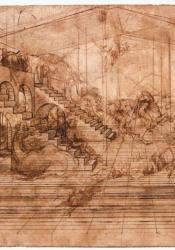Linear Perspective
During the Renaissance in Italy, artist and architects sought to understand how to more accurately portray three dimensional objects in a flat plane. This led to the development of linear perspective, a system of creating the illusion of depth through the use of lines that converge at a single vanishing point on the horizon line. As an apprentice in Andrea del Verrocchio’s studio, Leonardo was introduced to the rules of perspective through De Pictura, a treatise on perspective written by the Italian architect Leon Battista Alberti in 1435. One of the clearest uses of linear perspective in Renaissance art is seen in da Vinci’s perspectival study for The Adoration of the Magi. This piece reflects da Vinci’s approach to creating a three-dimensional space on a flat plan and demonstrates his mastery of linear perspective.
Sources
Blumberg, Naomi. “Linear Perspective.” Encyclopedia Britannica, Encyclopedia Britannica, Inc. , 17 Mar. 2016, www.britannica.com/art/linear-perspective.
“Da Vinci - The Artist: A True Master of His Craft.” Museum of Science, Museum of Science, Boston, 2018, www.mos.org/leonardo/artist.
Image Retrieved from Wikimedia Commons, fair use

